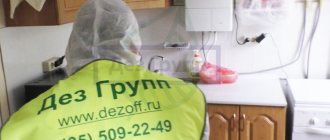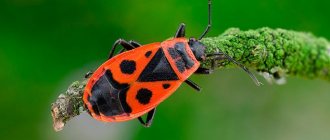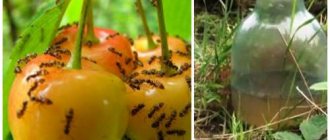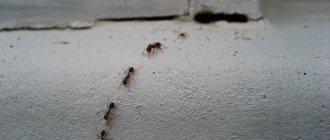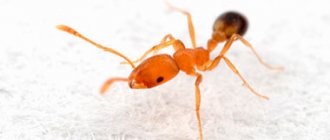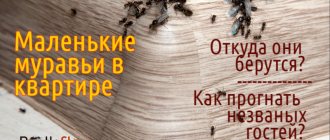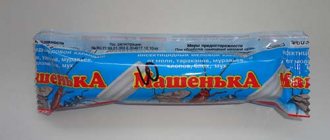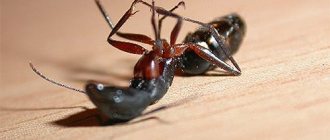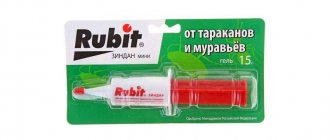Ants are one of the most common insects in nature. They can be found in almost any country, any climate and weather conditions. The only places where they have not yet been recorded are Greenland and Antarctica, as well as some isolated islands in the world's oceans. Ants are social creatures; they cannot exist alone. These insects have their own hierarchy of society, in which each individual occupies a certain place and performs the tasks assigned to it by nature. There is a queen ant whose main task is to perform reproductive functions. Other ants are divided into workers and males. The role of the former is to take care of the anthill family, and the latter is to continue the family line.
In this article we will look at the issue of ant life expectancy. Many people are interested in such information solely from a general educational point of view, and some people who have encountered ants at home or in an apartment want to know how long they will have to endure this scourge.
What does an ant look like?
On the body of the ant, the head and chest, a convex body with a bridge in the middle and three pairs of long, thin legs are clearly visible. The eyes are clearly visible, with which the insect actually sees poorly, only recording movements.
The mustache of ants is the most important assistant in their life. Thanks to them, they catch odors, detect food and their relatives. The legs have claws that help the insect move on any surface.
The body is protected from external influences by a chitinous shell. In some representatives of the species it can be reliable and durable, in others it can be thinner and more vulnerable.
The size of the insect is small - within 3 cm. Individuals of individual subspecies can be 1 mm.
Ants are capable of biting and secreting poison, so-called formic acid.
Lifespan of an ant
The lifespan of most ant species can last up to 5 years. In reality, almost none of them live that long. For various reasons, insects die quickly.
The uterus has the best chance of longevity. In their natural habitat, their lifespan is 3–6 years. There are cases when they lived for 15–17 years.
Females can live up to 9 months, males and workers - from several weeks to several months. Ants that choose residential apartments and houses as their habitat have a short life span of 1–6 months.
The situation is similar with garden ants. In just a year, the composition of the inhabitants of the anthill completely changes.
Lifespan of ants
So, how long do ants live? Let's look at this issue by comparing the life spans of insects depending on their specialization and, of course, species.
Life expectancy depending on specialization
Ants are insects in whose life everything is subject to order. Each of them performs their own, strictly specialized work. Some feed the queen and young, others are engaged in home repairs and searching for food. In different species, specialization and lifespan may vary, but the following patterns have been identified:
- Males are the shortest-living individuals. They are given only a few weeks to live. During this time, they must manage to fertilize as many females as possible so that their race does not die out. Then they die themselves, or they are killed by worker ants, who do not tolerate useless parasites.
- The queen is the longest living individual. In some species, its lifespan reaches 20 years! By comparison, a cat many times her size can only live up to 15 years.
- A worker ant is a hard worker who has only 1-3 years of life. A longer existence is irrational from the point of view of insects. After all, he is most susceptible to injury throughout his life. Loses limbs, antennae, and receives other injuries. And a disabled person’s productivity decreases, which means he becomes a burden for the family.
The above data only gives a general picture of the life expectancy of insects. In reality, they are much wider and depend on the species and some other factors.
Depending on the type
How many years do ants live, depending on the species? Scientists entomologists have identified the following features of their life expectancy:
- a working bulldog ant can live for at least 5 years;
- a red-haired apartment dweller, the pharaoh ant, lives no more than 2 months;
- The fewest parasitic species in the world exist of ants that steal supplies from other people's anthills - only a couple of weeks;
- The queen woodworm can live more than 25 years.
The list could go on for a long time, but in general, larger and sedentary species live longer, nomadic and small species live less. There are other factors that influence the lifespan of these insects.
Life cycle
The life cycle of an ant goes through all stages of transformation.
Stages of development:
- egg;
- larva;
- chrysalis;
- adult.
The first stage of development is the egg. The queen lays them in groups. They hatch into worm-like larvae. They begin to rapidly increase in size and turn into a pupa. The last stage is the formation of a full-fledged adult.
The entire process takes 4–6 weeks. Ants reproduce continuously. Household and garden pests are no exception.
Ant social classes
From a social point of view, ants (house and garden ants, including) are very organized insects. The population of any anthill is divided into castes:
- Uterus. The most important link is the queen (queen mother). It performs the most important function - it reproduces offspring. In a small anthill there may be one queen, in large ones there may be several. The queen mates once in her life. All the time he spends his time creating new ants. The resulting sperm are enough for her entire life cycle. This is where the queen’s interaction with the rest of the anthill practically ends.
- Males. Created only for reproductive function. After its successful implementation, they usually die.
- Workers. Most of the ant colony are underdeveloped females. They are unable to reproduce. Their main task is work. These are the worker ants that ensure the life of the anthill.
- Soldiers. Soldier ants perform a protective function and can also attack other colonies. These individuals are usually larger than others and more aggressive. It is a known fact that in some species soldier ants cannot feed on their own; worker ants feed them.
Principles of interaction in an anthill
There is such a thing - social insects. This means that each individual of a given species cannot live its life outside the system of interaction with each other. An ant cannot live without an anthill, because all its instincts are aimed at being part of the ant community, and not an independent unit.
An ant cannot live alone
An ant in an anthill is like a cell in a human body. Each cell performs its own function, thereby maintaining life in the body. And at the same time, each cell depends on the functioning of other cells.
Each ant in the anthill performs its own function, which is determined by the fact of its birth.
All ants performing their functions form and maintain the existence of an anthill. This means that all ants are interested in the efficiency of each ant.
Each ant in the anthill has its own role
Habitat and housing
Ant colonies can often be found in forests. There they build special nests for themselves - anthills. Also, these insects willingly settle in houses and apartments if they find favorable living conditions there. The pharaoh ant is the most commonly found species in human homes.
There are many chances to meet “uninvited guests” in your home in case of high humidity (dampness). Any unsanitary conditions are very attractive to ants. They can easily be found in trash cans, pet food bowls, and loosely sealed or packaged food items.
In private homes, pests make their home under the floor or in wooden ceilings. In apartment buildings - in basements. Then they scatter across the floors in search of food.
Garden plots are a favorite habitat for insects. They are attracted here by loose soil. It is convenient to build anthills in it. Cultivated plants are often attacked by aphids. Gardens treated against a small parasite are rarely of interest to ants.
Interesting Facts
Among the most interesting facts about ants are the following:
- Ants are considered the most ancient insects. Their history goes back about 100 million years.
- Scientists have data on more than 8,500 species of ants.
- These insects are considered the most developed. In this respect, they came closer to man than others.
- The main job of each individual is to prepare for winter. At night, all supplies are hidden in the house, and in the morning they are taken out into the air to dry. Ants are very sensitive to weather changes, so they will never dry out supplies before it rains.
- Each anthill has its own hierarchy.
- An ant colony always moves in a strictly defined order. She will find her way to her home under any circumstances.
- Food is distributed among family members by the queen.
It should be noted the extraordinary sense of justice of insects of this species. They will never abandon their sick or crippled brothers, they will take care of them and even feed them.
Needless to say, ants are an example of altruism and hard work. They are fair and very organized. Even people have something to learn from them.
Nutritional Features
Adults living in their natural habitat choose flower nectar, wild fruits, plant rhizomes, tree sap, seeds and nuts as food. Some species eat insects and their larvae.
Ants that have inhabited human habitation are greedy for sweets. Honey, jam, sugar are their favorite delicacies. They do not disdain other products, including waste.
Garden brethren eat honeydew, a sugary secretion produced by aphids. Don't give up berries.
What ants live near humans?
Several species of ants coexist with people.
Garden pests:
- Meadow. Small red-colored insects. Sizes vary from 6 to 12 mm. They build loose anthills with a diameter of about 3 m.
- Garden. Individuals are black/dark brown. The length of the body in males is 4–5 mm, in females - 1 cm. The main floors of housing are located underground, with a poorly visible hill on top. They can settle in tree trunks, under stones, etc.
- Forest. Distributed throughout the forests of central Russia. Large (7–15 mm) representatives of the ant genus of a dark red (almost brown) color. They build tall houses from small plant debris and branches.
The pharaoh ant most often visits a person’s home. Hence its other name - Brownie. The insect is usually red in color, 2–4 mm in length. There are also individuals of brown-yellow color. Males have wings.
Myrmica rubra: red myrmica
Insects of this subspecies are also called ruby ants due to their specific coloring and original chitinous cover. Ants are widespread in the European part, as well as in the Urals and Siberia.
Females of the red myrmica grow up to 6 mm at maturity and have a distinct reddish tint. Males are slightly darker and shorter – up to 5 mm. Anthills are located in the ground: under old logs, stumps and stones.
Myrmics are predators and, in pursuit of prey, paralyze it with poison. For humans, contact with ruby ant acid is quite painful and is accompanied by severe pain and redness of the skin. In the process of life, insects crush wood, thereby creating favorable conditions for the mineralization of cellulose-degrading bacteria.
Red myrmica
How do ants appear in gardens and houses?
Domestic parasites come from the street. First, ants start in basements or garbage disposals, then they penetrate directly into the house. Here you can always find some leftover food, crumbs, and pet food. Insects create a nest very quickly and it is extremely difficult to find it.
They get into vegetable gardens from nearby forest areas or from turf soil. Migrating colonies become residents in dacha areas. Another pest, aphids, will help make them stay for a long time.
METHODS OF FIGHT
In temperate climates, it is advisable to carry out disinfestation measures against ants inside heated rooms in the fall, winter or early spring - before they begin migrating outside. Most often, the problem of ants in multi-story buildings worsens during these periods.
The main methods used against ants include bait and contact treatment with liquid insecticides (both acute or rapid action, and long-term residual, or “barrier”). Both of these methods are successfully used by pest control services, both in combination and separately.
How do we kill ants?
When working with acute-acting preparations (provided that only part of the area populated by ants is being treated), it is difficult even for qualified disinfectors to avoid unpleasant side effects, such as the spread of insects. Therefore, we, like other professional services, also use long-acting preparations - microencapsulated and other forms of products that remain active on the treated surface for a long time. They do not cause alertness to ants, do not have a repellent effect, and provide a barrier effect for 3 to 6 months after application.
Our company’s employees destroy both local breeding grounds of ants and carry out disinfestation of apartment buildings (apartment buildings). Contact insecticides and gel baits are used during treatments. Walls, baseboards, and kitchen furniture are processed. After the procedure, it is important to maintain the effect of the drug on the paths of movement of ants, refusing wet cleaning for 1 month. After the product expires, it is necessary to carry out general cleaning.
The products are provided with accompanying documents confirming their safety and effectiveness. The choice of the form of the product depends on:
- ease of use
- object type and conditions
- number of ants
- timing of application, aging of the product and its subsequent cleaning
- disinfestation safety requirements
If the absence of odor is important during treatment, or it is known that there may be ants in other apartments, then oil-water-based preparations, microencapsulated products, are prescribed. If moisture ingress during processing is undesirable, gels are used. At facilities where the minimum period of exposure of the product is ensured (with daily washing and cleaning), acute-acting agents are used. In other places where the product retains its effect, long-acting preparations are used, including microencapsulated and gel baits.
If you do not plan to spend money on services or do not trust the services, then you can remove the ants from the apartment yourself.
How to get rid of house ants yourself
- Destroy the crawling ants . This can be done in a variety of ways, including vacuuming the insects' habitats with narrow attachments or spraying them with window cleaner (or liquid soap) until they sink and then wiping them down. A solution of sugar and borax with water also works well.
- “Erase” the ant trail . Find the place where the ants are entering the house. This could be a vent, a door threshold, a hole where a pipe exits, or another location that leads somewhere outside. Keep an eye on the workers and see where they are going. You will understand where they are coming from. Knowing how ants move will help remove traces of their presence. Unlike the tracks of cockroaches, bedbugs and fleas, the track that an ant leaves behind cannot be seen with the naked eye. Largely because it consists of pheromones - chemicals that control their behavior. Check the places where you last saw ants. For example, most often the path is located at the seams or joints of the cladding - tiles in the bathroom or kitchen in the pocket area, next to the sink, along baseboards, furniture edges, and other similar places. To clean and remove marks, depending on the type of surface, use one or more of the following: a strong detergent;
- vinegar solution;
- cloth soaked in alcohol.
What is the most effective ant repellent?
When fighting ants on your own, it is better not to use contact insecticides (aerosols, sprays, acute concentrates).
- First, toxic chemical liquid insecticides can be dangerous to people and pets.
- Secondly, contact insecticides kill only those ants that they come into contact with when sprayed. But this will not affect the thousands of individuals in the nest.
- Treatment with an incorrectly selected drug will lead to working foragers leaving the nest and creating another one in safer territory.
The use of most contact insecticides in the form of powders, aerosols, and sprays only makes ants stronger. The sharp repellent effect of the drug is assessed by ants as an unfavorable factor that mobilizes their strength for survival. This causes the colonies to split into subcolonies and scatter, spreading deeper into the building. The scattering effect, also called budding, multiplies the number of ant colonies and makes the problem worse. The use of products without repellent properties does not lead to such separation and does not contribute to the further reproduction of insects.
If you do use aerosols, sprays or household insecticidal concentrates, then choose those that do not have a repellent effect. This will ensure that while you are looking for their nest, the product will not cause the ants to further disperse and spread into adjacent rooms.
Of the liquid preparations, long-acting insecticides (oil-in-water concentrates and microencapsulated products) are best for ants because these insects will not be able to detect them and will not try to avoid contact with the product. Such preparations, as a rule, do not smell or have a faint odor. Ants don't sense it either.
Another advantage is that during the action of these drugs it is possible to additionally use bait. The fact is that repellent insecticides, as well as acute insecticides, do not combine well with insect baits (gels), since they neutralize the effect of the attractant in the gel (or paste, if you make the bait yourself). As a result, the baits stop working, i.e. lure Of course, this does not apply to non-repellents, for example, long-acting drugs, which were mentioned above.
What are baits and how do they work?
Ant baits are a good way to get rid of ants and destroy their colony completely. It is safe because there is no need to prepare the room for treatment, as is required when spraying. This is effective, since baiting is a method of long-term poisoning; it only takes 5-10 minutes to apply the bait to the right places, and it will work for at least a couple of months.
Baits with slow-acting insecticides are best because ants tend to “test” the bait several times. The bait mixes a food attractant (a food component that attracts insects) and an insecticide (an active substance that kills pests). The ants take the bait back to the colony, which consumes it, including the queen. Instead of killing instantly, the delayed action of the venom allows sufficient time for the bait to be transported to the nest.
It is almost impossible to get rid of a severe infestation without using the mass extermination method that baits provide.
Choosing bait and 6 rules for using it effectively
When choosing ant baits, it is best to choose both sugar and fat based baits and protein/fat based baits. Pharaoh ants can be very resistant to bait and suddenly appear in different places. When placing recommended carbohydrate or protein based baits, consider the likelihood of ants changing positions over time. Some rules:
- As an active substance (poison that will kill ants), it is better to use insecticides with an active mechanism of intestinal action - these are drugs from the class of aminohydrazones (hydramethylnon), phenylpyrazoles (fipronil), as well as organophosphorus compounds (fenthion, chlorpyrifos, diazinon). Fast-killing insecticides and pyrethroid baits will only kill the ants you see, preventing workers from carrying the bait home to feed the queen, nesting workers, and brood.
- If you use ready-made bait, then most fish gels contain chemicals. If you make the bait yourself, you can use both boric acid and a long-acting insecticide (for example, a microencapsulated preparation) as the active ingredient.
- When the bait shows low effectiveness (ants do not visit the bait), change its base - sugar, egg yolks, minced meat, nuts, baked goods, or change the gel (if a ready-made form is used).
- Try to remove all other food sources while luring, leaving only the bait. Wait until one day the ants make a “path” to it. You should not move the bait if they have already found it.
- You need to be patient. The use of gels or manufactured baits requires a lot of time, because their action is slow (the approximate waiting period is 1-3 months). The first effect is often not achieved even in the first week of aging. Sometimes you have to wait more than a month for the effect. All the time you will find living and dead ants, there may be even more of them than there were before using the gels, this is a normal phenomenon in this case. In order for the gels to have their full effect on insects, you need to be patient.
- All the time while you are fighting ants, it is important to maintain order in the room, follow a sanitary prevention regime and basic hygiene rules.
How to lure the queen out of hiding
Pharaoh ants are so small that they fit through tiny cracks, crevices, and the tiniest holes you can see.
If the room inside is not inhabited (for example, you occasionally come across 1-2 ants), our advice is not to lure them on purpose. Working individuals hunt for “easy” food, so regular housekeeping procedures - cleaning, washing, scrubbing, using a vacuum cleaner - will be quite enough to avoid future infection.
But if you are still ready to eradicate insects, then the same baits will help you pull out the queen or even several queens. The tastier they are—sweeter and fattier—the more likely it is that the “queen” herself will come out to “try.” The degree of luring effectiveness is influenced by food preferences. It is better to lure those ants that lack protein with protein-containing baits. Conversely, ants that are forced to eat other insects are better lured with carbohydrates or oil baits. The bait that combines carbohydrates and fats works faster against red pharaohs.
How to determine if the bait worked
If the bait does not work for a long time, then perhaps you should try another one. Test your options. Change the bait until one of the products attracts most of the workers. The ants should cling to the bait from all sides and move towards it along the designated “path” in a chain of small working individuals.
Where and how do ants winter?
Insects that inhabit human homes and gardens do not hibernate when winter comes. Warm apartment conditions allow insects to live fully. Domestic parasitic individuals, unlike their wild counterparts, skip the food storage stage.
Garden ants do not leave their nests when it gets cold. They clog the entrances and move into the deeper layers. There are all conditions for continued existence. Insects prepare for the winter period in advance - they store food.
Benefits and harms of insects
The appearance of ants in a home or garden does not have good consequences for humans.
The harm lies in the following points:
- insect reproduction is uncontrollable and can develop into a real disaster;
- in apartment conditions, the activity of ants contributes to unsanitary conditions;
- garden ants breed aphids, which destroy vegetation;
- eat berries, vegetables and even flowers on the site;
- the soil under anthills tends to oxidize, as a result of which the plants planted nearby wither and become sick;
- pests often settle under the bark of fruit trees, build tunnels, thereby destroying the tree structure, turning it into dust;
- there is a possibility of living creatures moving into human habitation (this happens especially often in rainy, cold weather).
There are some benefits from ants:
- garden ants loosen the soil;
- destroy other insects, their larvae and eggs, which can damage plants.
The appearance and behavior of “garden” representatives of ants are not much different from their wild counterparts. Domesticated individuals partially change the process of life activity. They do not stop moving actively and do not store food. This factor leads to a constant increase in the number of insects. Control procedures become ineffective.
Lifespan of various species
Types of Ants Ants
that live in cold climates are active for a shorter period of time than their tropical counterparts. Therefore, we can conclude that the lifespan of insects depends on the species and climate.
Ginger
He clears the forest of harmful insects, but breeds aphids to collect their sweet juice. Every day, “forest orderlies” collect several thousand pest pupae and eggs.
A representative of this species can live for 5 years. But almost no one lives up to this point. Red ants are destroyed by forest birds and some small animals.
Pharaoh ant
Insects come from warm countries, so in harsh climates they live in apartments. Their life expectancy is short:
- in males - two months;
- for manufacturers – 20 days;
- the female lives 8-9 months.
The pharaonic species constantly lives without an anthill. In its nest there may be several queens, which produce large offspring - 30 thousand insects per year.
House ants are considered pests. Removing them can be difficult because the nest may be far from human eyes. And the size is small - 3 mm. It cannot boast of impressive weight either.
Garden
Arthropods prefer to settle under stones or in rotten stumps. But they can choose a person’s house or apartment to live in, the main thing is that the living conditions are suitable.
The lifespan of a garden ant is three years. But usually the anthill renewal occurs within one year.
Their life expectancy does not depend on how many ants there are in an anthill. This is influenced only by weather conditions, species, caste, and the presence of natural enemies near the anthill.
https://youtube.com/watch?v=5rE4tLhP5dM
